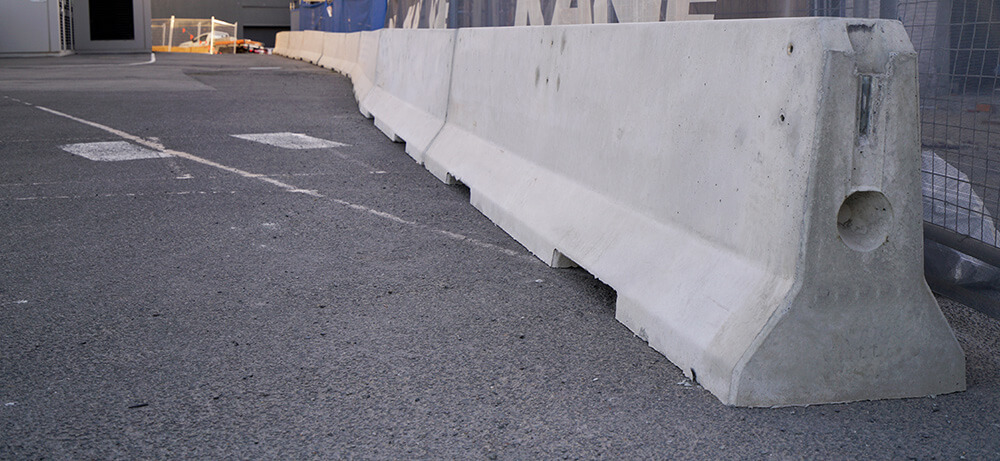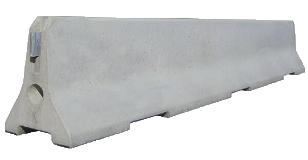Why do Concrere Jersey Barriers need to be tested and approved?
Concrete barriers are widely used on Australian roads. They reduce the risk of an out of control vehicle leaving the road or crossing the midline into oncoming traffic.
Although they appear to be a simple piece of equipment, there is a whole range of criteria that concrete barriers need to meet. Rigorous testing ensures that a barrier is safe, effective, and will perform as intended in a crash situation.
But with a whole range of abbreviations, test levels and technical terms, it can sometimes be hard to find the right barrier for your needs.
This article might help clarify some of the test methods, ratings and approvals you will come across when researching concrete jersey barriers.
Types of Concrete Crash Barrier Testing
Concrete jersey barriers are a type of longitudinal barrier. Their purpose is to deflect out of control vehicles so they continue moving along the barrier itself, as opposed to rebounding at a sharp angle into traffic.
Road barriers are tested for their ability to withstand impacts from a variety of vehicles travelling at different speeds. In simple terms, they are rated according to how much force they can absorb or deflect with minimum movement.
Although Australian Standard AS/NZS 3845 Road safety barrier systems and devices is applicable to concrete barriers, it largely borrows from the US when it comes to testing methods and approvals.
Some tests measure how severe the impact is, and the strain on passengers. How much the vehicle is redirected and how far the barrier moves out of place is also measured and categorised.
For concrete crash barriers, the following tests and ratings come into play.
- MASH
- NCHRP 350
- EN1317
Precast Concrete Barrier Crash Testing
NCHRP 350
The USA’s National Cooperative Highway Research Program (NCHRP) published a report in 1993. It covered recommended procedures for the safety performance evaluation of highway features including crash barriers and came to be known as NCHRP 350.
For many years NCHRP 350 was the go-to testing method for concrete crash barriers and other road barrier equipment. Barriers tested to NCRHP 350 are still valid and acceptable across a range of state authorities at present. However, as Austroads moves towards adopting MASH rated road barriers, state authorities are likely to follow suit.
MASH
The US Manual for Assessing Safety Hardware (MASH) presents guidelines for crash testing highway safety features. It also recommends evaluation criteria to assess these test results.
A MASH approved concrete crash barrier can be deemed to be up to date and tested to the gold standard of criteria. MASH testing has recently been adopted by Austroads as the best test method going forward, and the organisation is in the process of transitioning approvals for various traffic barrier systems from existing NCHRP 350 ratings to the newer (2016) MASH standards.
MASH Tested VS NCHRP 350: What’s the difference?
Both MASH & NCHRP 350 test results rate crash barriers dependent on their ability to withstand impacts. However, it is the method of testing that differs. In simple terms, MASH uses newer and heavier vehicles that more accurately reflect those that populate today’s roads.
MASH test levels are expressed as TL-1 through to TL-6, with the lower range being suitable for slow vehicles and pedestrian safety, and the higher range being suitable for fast moving and very heavy vehicles.
For example, the Deltabloc DB80 F-type concrete barrier is MASH approved to TL-3. This means it has been tested with a 2270kg ute travelling at 100km/hr impacting the barrier at an angle of 25 degrees (5 lane wide impact).
The DB80 Deltabloc MASH Approved concrete barrier offers low deflection for maximum safety. It is currently one of the few barriers on the market to already be tested and approved to Austroads’ new 2019 MASH standards.
National and State regulations for Concrete Jersey Barriers
Whilst all this testing is critical to ensure an effective safety barrier, ultimately each state’s governing body also plays a part in whether it is fit for use in the field. State transport authorities have the final say in whether they approve concrete barriers for use on their roads.
Nationally, Austroads is the peak organisation of Australasian road agencies. Amongst other things, Austroads conducts research and publishes best practice guidelines on road barriers. These are then reviewed, customised and adopted by the state transport authorities. These include:
- Roads and Maritime Services NSW
- VicRoads
- Department for Transport, Energy and Infrastructure, SA
- Department of Transport and Main Roads, Qld
The Fortress Fencing Deltabloc DB80 concrete jersey barriers are approved for use by both Austroads and these individual state authorities.
Deltabloc DB80 MASH tested road barrier
The Deltabloc DB80 concrete jersey crash barrier is RMS approved to minimise impacts from vehicles travelling up to 100km/hr in NSW & VIC, and 80km/hr in QLD.
Available in 2, 4 and 6 metre lengths, the DeltaBloc concrete jersey barrier is an excellent passive traffic safety tool.
This article is prepared as guide only. There are many other factors that need to be taken into account to determine the best concrete crash barrier for your needs. Our specialist team of concrete and safety barrier experts can provide all the documentation you require including test reports and approvals for DB80 concrete barriers. Get in touch with our concrete barrier experts today for more information.


Want to know more?
Contact us today for more information about the products used or to learn how we can assist with your upcoming project!
